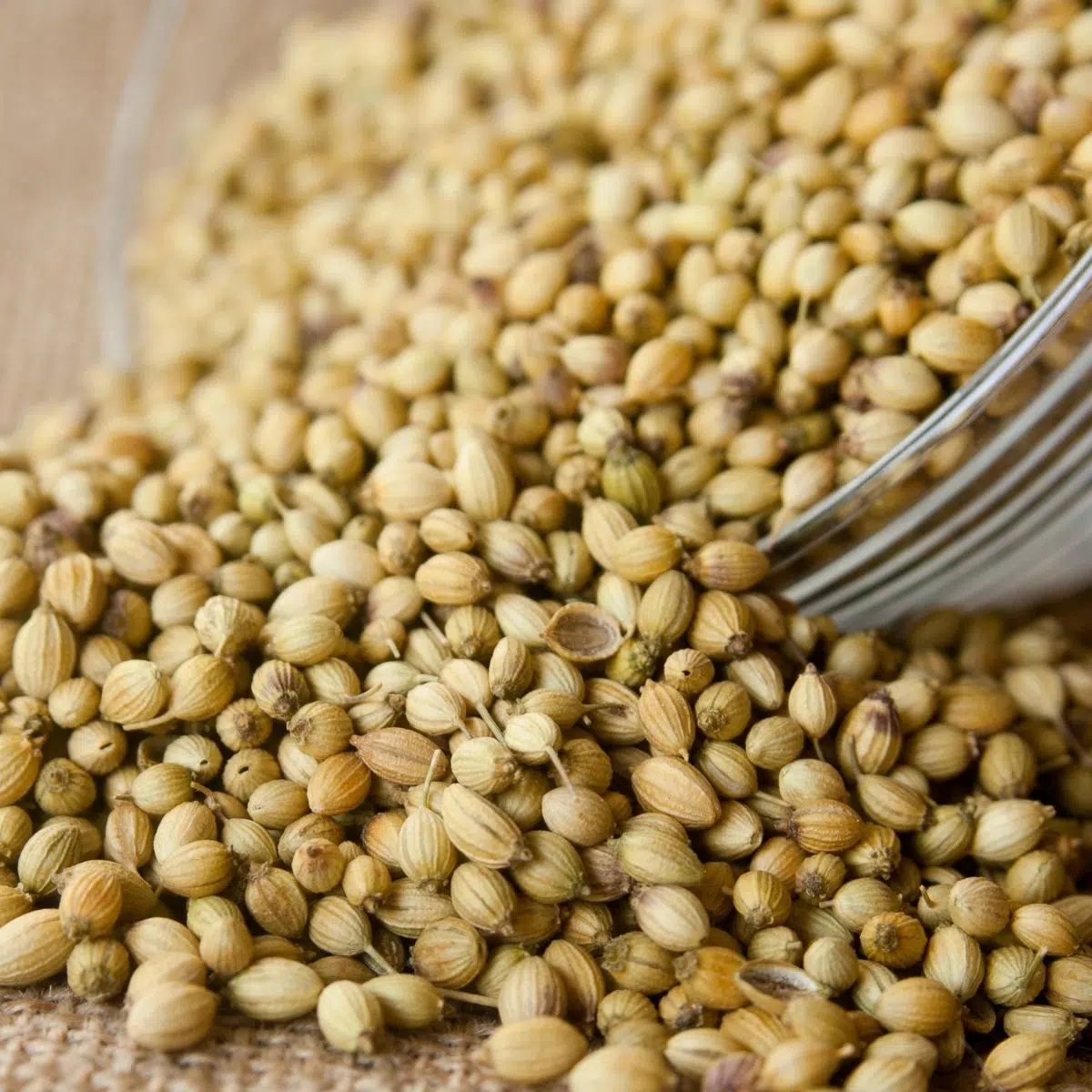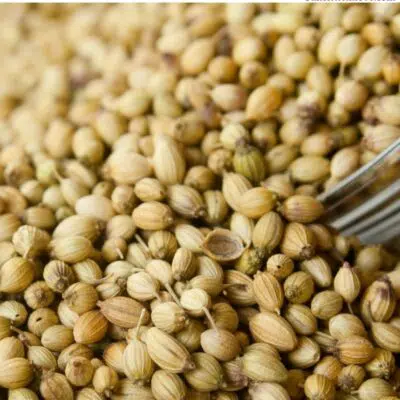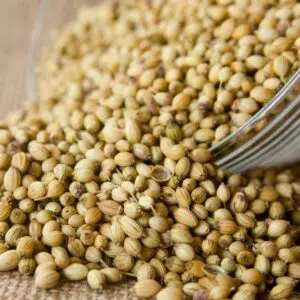You may think a coriander substitute is difficult to find due to the citrus-like and aromatic nature of this spice, but it's not! With my guide to the best coriander substitutes, you'll have a delicious dish in no time!

The best alternatives to coriander, no matter the recipe!
Welcome! If you are here then you have most likely run out of coriander when you were already in the kitchen ready to cook, or you need a similar (or different) flavor exchange for coriander.
Whatever your reason for seeking out a substitute, you are sure to find one that suits your needs in this lucky list of 13!
Jump to:
What is Coriander?
Coriander seeds from the coriander plant. The coriander plant is a member of the parsley family and has multiple parts that are used in cooking.
In addition to the seeds, which are a popular spice in many dishes, the leaves are also edible. Coriander seeds are usually just referred to as coriander, while the leaves of the plant are widely known as cilantro.
Even though they come from the same plant, cilantro and coriander seeds have different flavor profiles.
What does Coriander Taste Like?
While they are referred to as seeds, coriander seeds are technically the fruit of the plant that has been dried. You can find them in their whole form or ground.
Both the whole seeds and the ground powder have an earthy taste that often gets described as being floral. Cilantro has a bright and fresh taste with a little bit of spice and is usually used fresh instead of dried.
If you like cilantro, you think it has a bright fresh taste with a little bit of spice. If you hate cilantro, you probably think it tastes like soap (if this is you, check out some great cilantro substitutes to learn why).
How is Coriander Used
Coriander seeds are commonly used in their ground form. It is often heated or toasted, before being added to a dish, to help release the full aroma and flavor of the spice.
Whole coriander seeds are not as commonly used to season food but instead are used to add flavor during brining or pickling food.
While the coriander leaves (cilantro) are traditionally used in Latin American cuisine, coriander seeds are most frequently used in Indian, Middle Eastern, and Asian cuisine. It is used in dry spice rubs for meat, as an addition to marinades, or in seasoning cold dishes and salads.
The Best Substitutes for Coriander
1. Cumin
Even though cumin isn't an exact flavor match for coriander it shares similar earthy and nutty flavors that are like coriander. It is also one of the most common spices that people already have in their kitchens.
Two reasons this is considered by many to be the best substitute for coriander. The warm aroma of cumin is often associated with Latin American cuisine, but this spice is extremely versatile and used worldwide.
Another reason it is a great substitute for coriander. Use cumin in a 1:1 exchange for coriander in any of your recipes.
2. Caraway
Flavor-wise, caraway seeds are the closest match for coriander. The only downside is that this spice is one of the less common ones for people to have in their spice racks.
So, you may not have it on hand. If you are looking for a substitute for coriander for dishes though, and not just a quick alternative right now, consider adding caraway to your spice rack.
Caraway can be used in a 1:1 exchange for coriander; you can use ground caraway or the seeds.
3. Dried Parsley
Coriander is a member of the parsley family, so it makes sense to include parsley as a substitute. While fresh parsley is a good substitute for the leaves of coriander (aka cilantro), dried parsley is best as a substitute for coriander seeds.
Dried parsley will provide the earthy tones and aromas that come from coriander. It does best when used in hot dishes though, as sometimes dried parsley can overpower a simple salad.
Use dried parsley in an even 1:1 exchange for coriander.
4. Fennel Seeds
Fennel has a much different flavor profile than coriander. It is sweeter and has a strong anise (or licorice) flavor, but it does have some of the same earthy tones that coriander offers in a dish.
Even though it varies quite a bit in taste from coriander, it is used as a spice for many of the same types of dishes that coriander is used for. While the flavor may be different than coriander it will still complement your recipe nicely.
To give your recipe a new flavor twist, substitute fennel seeds in a 1:1 substitution for coriander. Fennel is especially delightful when paired with roasted root vegetables.
5. Curry Powder
Since coriander is commonly used in Indian and Asian cuisine, curry is a natural choice for a substitute with similar flavor profiles. This is because many curry seasoning blends have coriander in them.
Along with coriander, curry includes several other spices that create a more complex flavor in your dish. This can be a delightful way to enrich the flavors of stews, sauces, or marinades. Especially if you want to add a hint of sweetness, as curry is often naturally sweeter than coriander on its own.
Curry can be used in a simple 1:1 exchange for coriander. However, if your recipe calls for a lot of other spices (in addition to the coriander) consider beginning with half the amount of curry so you do not overpower your dish. You can always add more as needed (or desired)!
6. Garam Masala
Garam Masala is a spice blend that is native to India. There are many staple spices used in Garam Masala, often including coriander.
Each blend varies depending on what region in India it comes from though, so how prominent the coriander is will vary from each blend. Like curry, using Garam Masala will enrich your dish with several different flavors.
Depending on the blend of Garam Masala you have, this can elevate the spiciness or sweetness of your dish - taking the flavor beyond just a simple single spice. Use Garam Masala in a 1:1 substitution for coriander.
Like curry, if you have several other seasonings in your dish start with less Garam Masala or leave out some of the other single seasonings.
7. Oregano
Oregano is a more familiar flavor for many people as it is widely used in dishes around the world. Its strong earthy flavor is a good substitute if you are cooking for a group of people who may not enjoy the taste of coriander.
Oregano can be used in both hot and cold dishes, as well as to season dressings and marinades. Use oregano as a simple 1:1 substitute for coriander.
8. Basil
Basil is another substitute that like oregano provides a flavor many people are already familiar with and enjoy. As a fresh herb, basil provides hints of mint and a slight anise (licorice) flavor.
Even though it is not a close flavor match to coriander, it works well as a substitute because it is versatile in many dishes and can enhance the flavors in a similar way that coriander would. Dried basil is best used as a substitute in hot dishes, while fresh basil will add the best flavor to salads and cold dishes.
Use dried basil in a 1:1 substitution for coriander. Fresh basil is a little harder to match with an exact ratio, so feel free to eyeball it or you can chop up a couple of basil leaves to approximate the volume needed in your recipe.
9. Cilantro
Even though they come from the same plant, fresh cilantro does not have the exact flavor profile of coriander. Cilantro will provide a brighter and more citrus flavor element with a hint of spice, rather than the warm earthiness of coriander.
However, they do come from the same plant! This means that cilantro can add some of its own flavor in a complimentary way, too many dishes that call for coriander.
As cilantro is best used fresh, it is a good choice for cold dishes. Be mindful that many people do not love the taste of cilantro though, so if you are cooking for other people you may want to choose a different substitute. Chop fresh cilantro for an approximate 1:1 substitution of coriander in salads or dressings.
10. Tarragon
Tarragon is a common herb used in French cooking. It is not quite as popular in the United States, but more people are starting to become familiar with it. Tarragon offers similar earthy tones to coriander, as well as a hint of licorice.
It pairs well with chicken and egg dishes and would be a lovely substitute for coriander in a similar dish. Use tarragon in a 1:1 exchange for coriander.
If you find that the flavor is not strong enough, feel free to add a bit more.
11. Herb Blends
Many herb blends include coriander in them. Italian seasoning and Herbs de Provence are two common ones you may already have in your kitchen.
Many other blends don't have coriander in them but could be a nice flavor change. Look in your cupboard and see what blends you may have available to try.
In general, herb blends are a great choice to use as a dry rub for meat or to season roasted vegetables or hearty casseroles. How much to use as a substitute will depend on the herb blend.
Start with about half of what the recipe calls for in coriander and then add more as needed to reach your desired flavor.
12. Dill
If you don't like the taste of coriander, then dill can be a nice choice to change the flavor but still have a similar overall outcome to the recipe. Dill will brighten up the flavor of a dish.
Dill is best used fresh to add as a flavorful garnish on top of a dish just before serving. It is also a good addition to salads. Dill has its own very distinct flavor, so make sure you like the strong taste of dill before using it as a substitute.
Compared to coriander, dill can be quite strong. Start with about half of what the recipe calls for in coriander and add more if needed.
13. Turmeric
Turmeric has a strong earthy flavor that is more pronounced than coriander, but it is mild and does not contain floral or nutty aromas. As another traditional spice used in Indian, Middle Eastern, and Asian cuisines though, it can offer a familiar taste to many dishes that call for coriander.
Turmeric is best used in stews and other hot dishes where it can be fully incorporated into the other ingredients and play off their flavors. It will also pair well with many other spices, so consider exploring a substation that includes turmeric and another choice from above.
Start with half the amount of turmeric that the recipe calls for in coriander. Then feel free to explore using more or adding in additional spices.
We hope this information helps you to choose a flavorful alternative to coriander! Let us know what substitutions you would like to see next by commenting below!
Do you love a recipe you tried? Please leave a 5-star 🌟rating in the recipe card below and/or a review in the comments section further down the page.
Stay in touch with me through social media @ Pinterest, Facebook, Instagram, or Twitter! Subscribe to the newsletter today (no spam, I promise)! Don't forget to tag me when you try one of my recipes!
📖 Recipe Card
Coriander Substitute: Best & Most Common Alternatives (13 Great Ideas!)
Ingredients
Option 1 (Most Common) - Cumin
- 1 teaspoon cumin
Option 2 (Best Flavor Match) - Caraway Seeds
- 1 teaspoon caraway seeds
(Note: 2x or 3x only changes the ingredient list)
Instructions
Option 1 (Most Common) - Cumin
- Cumin can be used in a 1:1 ration as the coriander that is called for in any recipe.
Option 2 (Best Flavor Match) - Caraway Seeds
- Caraway seeds can be used in a 1:1 ration as the coriander that is called for in any recipe.



Comments
No Comments